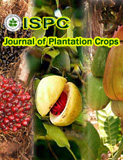Variation in phenolic compounds and antioxidant potential in arecanut of different selections and processing methods
DOI:
https://doi.org/10.25081/jpc.2022.v50.i1.7788Downloads
References
Amudhan, M.S., Begaum, V. H. and Hebbar, K.B. 2012. A review on phytochemical and pharmacological potential of Areca catechu L. seed. International Journal of Pharmaceutical Sciences and Research 3: 5151-4157.
Anthikat, R.R.N. and Michael, A. 2012. Anti-inflammatory and antioxidant effect of Areca catechu, International Journal of Pharmaceutical Sciences and Research 3(6): 2031-2037.
Anonymous. 2020. https://www.dasd.gov.in/adminimage/ Arecanut area and production 2020. pdf.
Banjarnahor, S. D. and Artanti N. 2015. Antioxidant properties of flavonoids. Medical Journal of Indonesia 23(4): 239-44.
Benzie, I.F.F. and Strain, J.J. 1996. The ferric reducing ability of plasma (FRAP) as a measure of antioxidant power: The FRAP assay. Analytical Chemistry 239: 70-76.
Blois, M.S. 1958. Antioxidant determinations by the use of a stable free radical. Nature 181: 1199-1200. http://dx.doi.org/10.1038/1811199a0.
Chun, O.K., Kim, D.O., Moon, H.Y., Kang, H.G. and Lee, C.Y. 2003. Contribution of individual polyphenolics to the total antioxidant capacity of plums. Journal of Agricultural and Food Chemistry 51: 7240-7245.
Ferreira, I. C. F. R.; Baptista, P.; Vilas-Boas, M. and Barros, L., 2007. Free-radical scavenging capacity and the reducing power of wild edible mushrooms from northeast Portugal: Individual cap and stipe activity. Food Chemistry 100: 1511-1516.
Halliwell, B., Gutteridge, J. M. C. and Cross, C.E. 1992. Free radicals, antioxidants, and human disease: Where are we now? Translational Research 119(6): 598-620.
Jaiswal, P., Pradeep, K., Sing V.K. and Singh, D.K. 2011. Areca catechu L: A valuable herbal medicine against different health problems. Research Journal of Medicinal Plants 5(2): 145-152.
Kang, H.M. and Saltveit, M.E. 2002. The antioxidant capacity of lettuce leaf tissue increases after wounding. Journal of Agricultural and Food Chemistry 50: 7536-7541.
Nilima, S.R. and Hande, S.M. 2011. Estimation of phytochemical content and antioxidant activity of some selected traditional Indian medicinal plants. Indian Journal of Pharmaceutical Sciences 73(2): 146-151.
Peng Wei,Yu-Jie Liu, NaWuTao, SunXiao-Yan, He, Yong-Xiang GaoChun-Jie Wu. 2015. Areca catechu L. (Arecaceae): A review of its traditional uses, botany, phytochemistry, pharmacology and toxicology. Journal of Ethnopharmacology 164: 340-356.
Rashid, S.M., Shamsi and Ahsan, I. 2015. Areca catechu: Enfolding of historical and therapeutic traditional knowledge with modern update. International Journal of Pharmacognosy 2(5): 221-228.
Robards, K. P.D., Prenzler, G. Tucker, P. Swatsitang, W. and Glover. 1999. Phenolic compounds and their role in oxidative processes in fruits. Food Chemistry 66: 401-436.
Singleton, V.L. and Rossi, J.A. 1965. A colorimetry of total phenolics with phosphomolybdic-phosphotungstic acid reagents. The American Journal of Enology and Viticulture 16: 144-158.
Zhang, W.M., Li, B., Han, L. and Zhang, H.D. 2009. Antioxidant activities of extracts from areca (Areca catechu L.) flower, husk and seed. African Journal of Biotechnology 8(16): 3887-3892.
Zhang, X., Wu Jiao, Han Zhuang, Mei Wen-li and Dai Hao-fu. 2010. Antioxidant and cytotoxic phenolic compounds of arecanut (Areca catechu). Chemical Research in Chinese Universities 26(1): 161-164.
Published
How to Cite
Issue
Section
Copyright (c) 2022 Journal of Plantation Crops

This work is licensed under a Creative Commons Attribution 4.0 International License.







 .
.